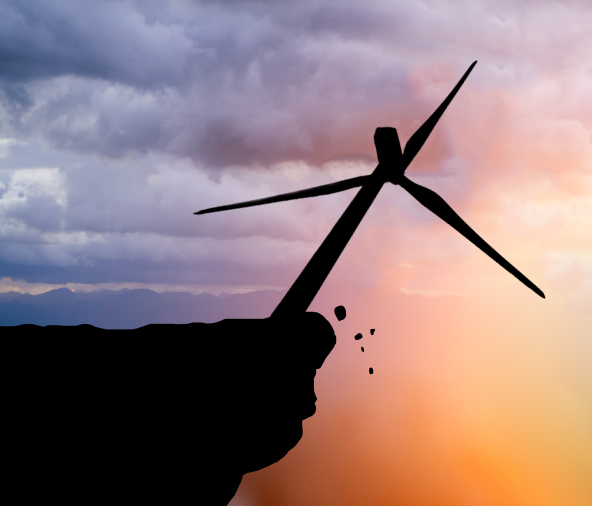I’ve just returned from an expedition to the Yucatan Peninsula to see for myself. And I can confirm: The Mayan prediction of the end of the world is real and the threat is imminent. Two minor caveats, though. The first is that the key date isn’t Dec. 21, it’s Dec. 31. And the second is that all of civilization isn’t at risk — just the U.S. wind industry. So that’s kind of good news, I guess.
What’s putting the wind industry at risk, as you may remember and as the Mayans savvily predicted, is the expiration of the wind production tax credit, an incentive given to electricity producers to use wind energy. It’s a key prop for the industry, allowing it to compete in a sector heavily biased toward long-standing fossil-fuel-based systems. First introduced under President George H. W. Bush, the credit (and other similar renewable credits) has been regularly renewed since. With the production tax credit in place, wind has seen growth. Without it?
If not renewed, industry advocacy group the American Wind Energy Association predicts the loss of 37,000 jobs — and perhaps a complete collapse in new wind installations.
Over the course of the summer, the future of the wind PTC was uncertain. In June, even conservative stalwarts like Karl Rove came out in support of extending it. But in September, Mitt Romney, who had yet to begin his post-election tour of middle America, came out forcefully against an extension. With Romney leading the party, the effect was to solidify Republican opposition to the tax credit, greatly complicating the situation for proponents.
Those calling for an extension, including AWEA, have seemed stumped on how to get an extension passed on Capitol Hill. Even Democratic members of Congress have been surprisingly indifferent to the issue — particularly in light of fierce, hypocritical, Koch-backed opposition.
With 18 days left before expiration, the fight is picking up. On Wednesday, former President Clinton brought his campaign mojo to Chicago, celebrating the Midwest’s spike in wind installation. A group of veterans stormed D.C. to push for a renewal and the jobs that would result. Even religious leaders are speaking out, with the Evangelical Environmental Network and others holding a press conference this morning arguing that the transition to cleaner energy sources is a moral imperative, given the health damage done by fossil fuels.
Opponents have also moved into action: Exelon, a nuclear energy provider, is asking its employees to contact Congress to oppose the extension. A coalition of groups linked to fossil fuels held its own press conference today. (Spoiler for everyone, everywhere: Press conferences are always useless and you should stop having them.)
Yesterday afternoon, a breakthrough by AWEA. No, it hadn’t cobbled together enough votes to win the fight. Instead, it agreed to support an appeasement, a gradual decrease in the PTC until it goes away completely. From AWEA’s letter to congressional leaders [PDF]:
Time and again the industry has made the case to Congress for a PTC renewal, and with overwhelming bipartisan support, the credit has been extended in order to drive more efficient, cheaper and cleaner energy. Still, the stop-start nature of short-term extensions has made it difficult to get the industry to a place where it can be fully cost-competitive. …
The industry has undertaken an extensive analytical effort to determine what level of the PTC over a specific number of years would be needed to keep the industry minimally viable. The analysis assumed that the industry would meet ambitious technology-improvement and capital cost targets. Analytical results indicate that a PTC beginning with 2.2 cents per kilowatt-hour, or 100% of the current level for projects that begin construction in 2013, followed by 90%, 80%, 70%, 60%, and then 60% of the current level for projects that are placed in service in years 2014 through 2018, with no PTC in 2019 or afterwards, would sustain a minimally viable industry, able to continue achieving cost reductions.

This image, yet again.
Neville Chamberlain would be proud. There is no better way to negotiate than to accede to a tremendously weak position early in the process. Opponents of the PTC are unlikely to accept this position as-is, and will instead push for a faster, more severe reduction, making AWEA’s already-bad position even worse. And AWEA concedes a key conservative talking point: that the PTC isn’t needed, that wind can compete on a lopsided playing field in a few years. That’s probably extremely optimistic.
This proposal is also hugely damaging to other renewable energy sources, like solar, which have production tax credits expiring at the end of next year. How will the solar industry defend its extension — an extension which, again, used to be routine — if the wind industry has set a standard of a gradual phasing out?
Another thing: The fossil fuel industry’s $4 billion-a-year subsidy, now in its second century, is not subject to a phaseout. (These subsidies are something that AWEA’s CEO, Denise Bode, knows about; she used to be president of the Independent Petroleum Association of America.) A large part of this is because the fossil fuel industry has grown tendrils that reach deep into the American political power structure, a slow, deliberate process. That’s made it hard for the wind industry to win political fights, but it’s not insurmountable. Acquiescing to a phaseout of wind without calling for a similar phaseout of fossil fuel subsidies is bizarre.
At some point within the next 18 days, one of two things will happen. Congress will pass legislation that enacts a phaseout of the wind PTC over time, or Congress will do nothing and the PTC will vanish. Both will damage wind’s massive growth as a provider of both electricity and jobs. The question is how much and how soon.
And how on earth the Mayans saw all of this coming.




